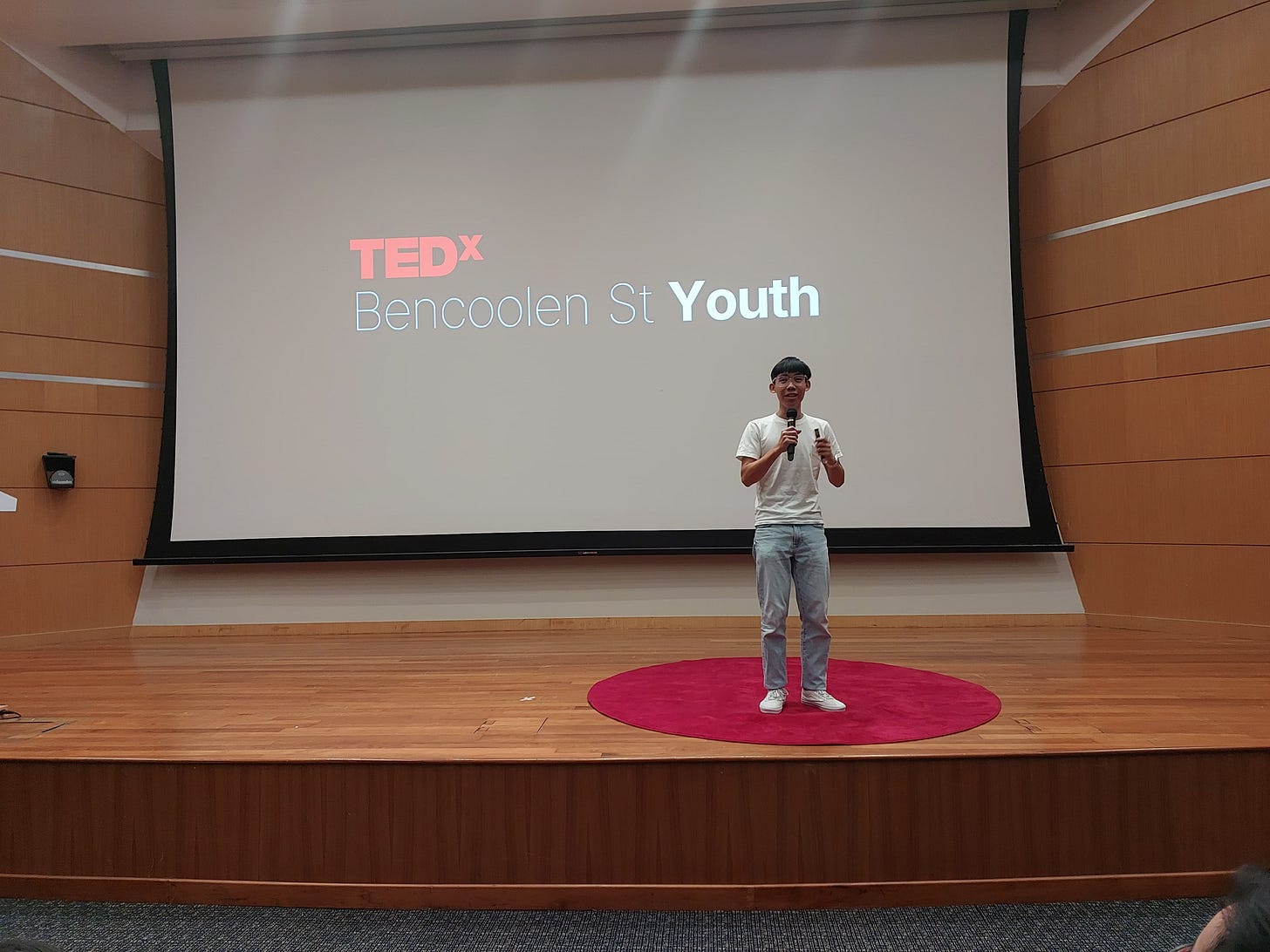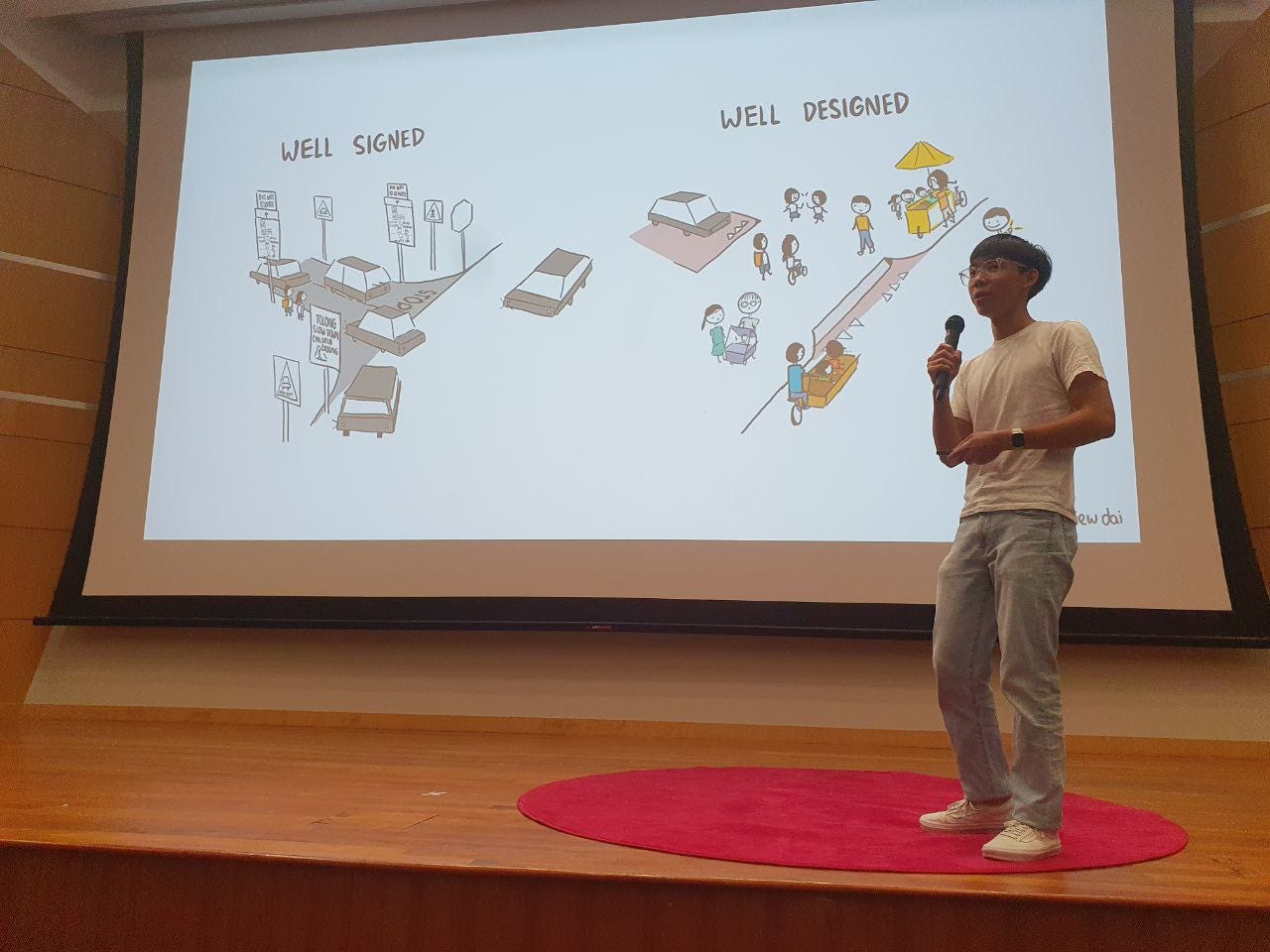My First TEDx Experience
Here's what I did - yap about streets in an auditorium
Invitation to Speak
A notification popped up in my inbox. It read “We will be holding a physical TED event in March 2025, and we would like to invite you to be a guest speaker at this event. The details are as follows…”
I have watched many TED talks about urban design, usually spoken by people in the industry itself like Jeff Speck or Mikael Colville Andersen and I thought “How could an advocate who has no traffic engineering or urban planning paper qualifications be speaking at such a big talk? Then how?!"
With the support of people around me, I made the choice to take up the opportunity, because why not?
The Preparation
There were many things I wanted to share with the world, such as ideas on cycling and public transport. But what I thought was most important was the idea of street redesigns.
Why so?
While there is a general notion that prioritising public transport and providing cycling lanes are necessary, adding these two features alone cannot make a city liveable nor walkable. For example, a 20 lane road with bus and bike lanes on both sides is a scar in a city’s urban fabric. Singapore has built many roads to flow efficiently, but what makes its urban environment sterile is the lack of streets.
“Singapore has no space” is a commonly used excuse to defend car-centric designs, as if they had been this way all the while. However, diving into history revealed how they were once public spaces, like extensions of people’s living rooms, only to be taken away from them with the popularisation of the automobile.
When designed for “efficiency and speed”, the character of streets disappear, making the urban environment feel like being in a part of a gentrified Southeast Asian City such as BGC.
Discussing such issues in Singapore over the years often results in responses that can be summed up as “then how?”. Citizens would say they feel powerless, engineers would say some ideas couldn’t be found in a manual, and perhaps the risk averse culture Singapore has would mean building more of the same - asphalt filled streets with parking lots on both sides; when cities around us have been shifting gears to designing more human streets.
Being a person trained in the arts, I thought about how designers think differently from engineers. To an engineer, efficiency appears to be the goal. To a designer, the end user’s needs is the goal.
Perhaps our streets have been designed precisely wrong than vaguely right, imposing mathematical models onto public space that’s supposed to be human.
How would our streets look like if everyday people designed them? Could that result in a friendlier neighbourhood?
I think it’s possible. They’ll be beautiful, and more importantly, safer for all.
The experience
Meeting other speakers at TEDx was interesting to say the least. Being a youth event, some speakers were as young as 15, eager to share their ideas on stage. Some were older, but nonetheless provided a heap of youthful energy. I was amazed by the level of courage and openness everyone had during our conversations, and while all of us had varied levels of stage fright, being in the same boat brought me great comfort.
The doors opened and members of the public started to fill the auditorium. Well, perhaps half-full because TEDx events have a size limit of 100 people.
Listening and observing to others’ speeches made me pick up several presentation skills, such as looking at the audience while not focusing too much at one corner, and speaking slower to focus on eununciation. Bringing out a casual tone between the audience and the speaker was also of great importance, as could be found in Mr Jack Sim’s speech about toilets. Speeches passed by quickly, and it was soon my turn to speak after the intermission.
The gust of air con made me shiver, and I headed to the outdoor waiting area to warm up my body.
I was so puzzled. How is public speaking scarier than performing an instrument on stage? But perhaps, just like playing an instrument, it requires a lot of practice to gain confidence, to which, public speaking is a “new instrument”.
Not long after, the emcee called the audience to head back to their seats, presented a short introduction of my background, and the stage was set. The spotlight shoned on the red carpet and there I was. With a dynamic mic and a clicker in my hand, the start of 18 minutes began.
“Good morning, I’m Vareck. Let’s talk about streets…”
Thankfully, I had quite a number of graphics and drawings to guide me along the way, as I find art a (way) easier medium to present my ideas than writing, let alone speaking.
As I continued talking and improvising as I went, time flew by and it was time for the audience to clap. Heading back to my seat, I thought - a month of preparation condensed into a short presentation and it was over so quickly! Basking in the post-”presentation” high, I felt a wave of relief and accomplishment. I couldn’t believe I did it!
If given another chance to speak again, would I go for it?
I guess I’ll be worrying less about “then how?” and going straight to “why not!”
The recorded video will be published on TED’s channel sometime soon, where you can see me hopping around the stage like a bouncy castle, and forgetting to wrap up my presentation with “why not”.
But hey, nothing is perfect, like how a character in my drawing has an unshaded leg.
Thank you to TEDx Bencoolen St Youth for inviting me to be a speaker! It was such a great opportunity to learn from others and share what I’ve learned so far.






